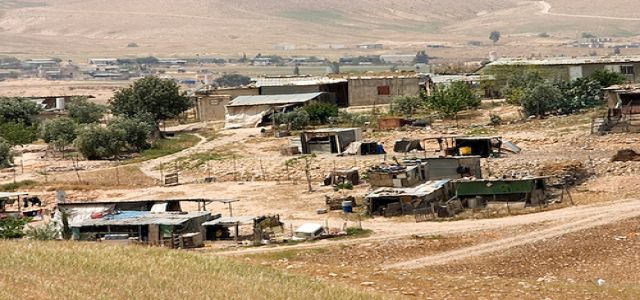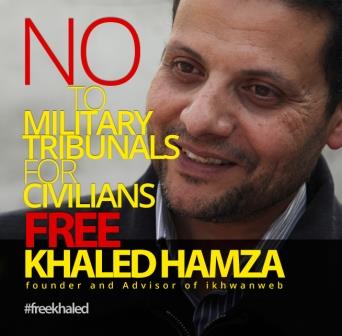|
|||||||||
| Palestine | |||||||||

Legalizing injustice in the Negev and implications for “democracy” in Israel
Nasser Rego considers the legal and political framework of the escalating ethnic cleansing of the Negev – or Naqab – by the Israeli authorities and argues that, given the fracturing of the “solomonic pillar of law propping up Israel’s democratic facade”, the time has come for the international community to fulfil its responsibility to protect Israel’s imperilled Arab citizens.
|
|||||||||
| Sunday, August 8,2010 19:52 | |||||||||
|
|||||||||
|
Nasser Rego considers the legal and political framework of the escalating ethnic cleansing of the Negev – or Naqab – by the Israeli authorities and argues that, given the fracturing of the “solomonic pillar of law propping up Israel’s democratic facade”, the time has come for the international community to fulfil its responsibility to protect Israel’s imperilled Arab citizens.
The legal fiat granted by these legal provisions enabled the demolition of the entire housing of 300 residents of the unrecognized village of al-Araqib, the uprooting of olive and carob trees, the destruction of animal pens and chicken coops, the confiscation of personal belongings, the damaging of water canisters and the confiscation of power generators. The canisters and generators were there because residents of al-Araqib are deliberately denied water and electricity, like 83,000 other Palestinian Arab residents of the Naqab’s unrecognized villages. It meant around 200 children without a home in al-Araqib. The Regional Council for the Unrecognized Villages, a Naqab-based non-governmental advocacy, said that only a few dozen people from al-Araqib have other homes.2 The destruction of the village was directed by a 1,300-strong contingent of security forces and police equipped with guns, stun grenades and bulldozers. Human Rights Watch reported that an appeal was filed by residents prior to the demolition. The residents argued that the state had no legal grounds to demolish their homes. However, their appeal was rejected by the Kiryat Gat Peace Court (court of first instance) at 12:15 a.m. on 27 July, the morning of the demolition.3 Police and security forces, however, began congregating at the junctions around al-Araqib on 26 July. Dr Awad Abu Freih, spokesperson for al-Araqib village and resident, took that as evidence that the appeal to the court was a foregone conclusion.
The motivation for uprooting the land and destroying building structures is part of an ongoing state policy towards the non-recognition of historical land use, ownership and possession of Naqab lands by the Arab Bedouin that are indigenous to the area. Its purpose is spelt out in a document issued by the Israel Defence Forces (IDF) and classified “secret”. The document is entitled “Transferring Bedouins from the Negev” (Doc. No. 54-84811959) and was issued on 14 November 1951. It states that security and financial reasons are the primary reasons to transfer the Bedouin from the Negev. The document refers to nine specific tribes and says that they live on 100,000 dunams of land, land which is fertile and so they are an obstacle to future [Jewish] settlement and development. The purpose is less explicitly stated in the Jewish National Fund’s (JNF) initiative that informed the destruction of al-Araqib village – the “Blueprint for the Negev”. Blueprint Negev, JNF's 600-million-dollar campaign to develop the region, states that the initiative will bring about a 70 per cent population growth in the Negev, reduce unemployment, enhance the quality of life for all residents and “build a stronger Israel”.5 Ethnic cleansing helped by the Jewish National FundJNF green thumb endeavours to plant a forest on al-Araqib lands and enable Jewish settlement on those lands has meant having to free the land of the “obstacles” and “nuisances” in the way. These “obstacles” and “nuisances” are Arab Bedouin of the Naqab. However, what is especially troubling is not that particular human beings are considered “obstacles” and “nuisances” that have to be cleansed off the land but two more urgent issues that flow from the fact. First, that the court, that pillar of democracy whose purpose is to uphold the rule of law and ensure that administrative action is not arbitrary and discriminatory, is at times actively engaged in arbitrary and discriminatory action. The character of this action is “the planned deliberate removal from a specific territory, persons of a particular ethnic group, by force or intimidation, in order to render that area ethnically homogenous”, the definition of “ethnic cleansing” offered by the UN. Second, that such action is only the beginning of similar action in the near future for the indigenous community of 83,000 from the Naqab’s unrecognized villages.
The fragility of the Israeli legal system’s authority is demonstrated in how local authorities explicitly dismiss certain court orders, such as those issued with regard to Umm al-Hieran. In October 2006, the Beersheva Magistrate Court decided to postpone the execution of a judicial evacuation and demolition order it had issued in August 2004 against Umm al-Hieran, following a motion filed by the human rights organization Adalah. However, the order for postponement was ignored by the planning authority, the Israel Lands Administration (ILA), which then went ahead with demolishing nine homes in June 2007.10 On 30 July 2009, the Beersheva Magistrate Court issued further judicial evacuation orders with the aim of realizing the government intension to remove the roughly 1,500 people living in the sister villages of Atir and Umm al-Hieran to make way for the Jewish settlement of Hiran and to facilitate continued JNF forestation efforts there.11 International responsibility to protectAt this juncture, we are forced to question the substantive relevance of the “rule of law” in Israel. If the courts issue judicial demolition and evacuation orders for entire villages as they did for Atir and Umm al-Hieran, and as they have acquiesced to in al-Araqib, and the legal avenues to challenge such orders are slim, what recourse do people suffering from discriminatory government action have? To where do they turn if not the legal system? If indeed we are witnessing an escalation of government policy in the Naqab towards ethnic cleansing sanctioned by the judiciary, what role is the international community obliged to play? Does it have a “responsibility to protect”, to intervene when crimes against humanity such as ethnic cleansing take place?
The principle of “responsibility to protect” was explored in the 2001 report of the International Commission on Intervention and State Sovereignty (ICISS) that studied the moral and legal responsibility of states to protect their inhabitants. The UN General Assembly later adopted Resolution A/RES/63/308 on the Responsibility to Protect in 2009, agreeing to continue discussions on the principle. The principle holds that states bear primary responsibility for the protection of the people under their care. When states fail to make good-faith attempts to fulfill this responsibility, it devolves upon the international community of states to protect populations at risk from domestic threats such as severe state repression and crimes against humanity.12 Netanyahu’s harking to the Balkans is indeed ironic. The national rights and autonomy that the Kosovar Albanian minority were demanding stemmed from widespread and systematic cultural and political marginalization in Serbia. As Slobodan Milosevic launched a brutal offensive against Kosovar Albanians, the world was witness to some of the worst ethnic cleansing, genocide and crimes against humanity since World War II. Notes1. Case BS 008759/05, State of Israel vs. Person Unknown, Beer Sheva Magistrate Court, 21 November 2005 (on file with Human Rights Watch), Human Rights Watch, Off the Map: Land and Housing Rights Violations in Israel's Unrecognized Bedouin Villages (2008) at 72-73. 5.http://support.jnf.org/site/PageServer?pagename=NewMinisterOfNegevDevelopment. 12. For a challenging exploration of the international law principle of the ‘responsibility to protect’ see Natalie Oman, “The ‘Responsibility to Prevent’: A Remit for Intervention?”, 22:2 Canadian Journal of Law and Jurisprudence (July 2009) 335-380 Nasser Victor Rego is a civil and human rights expert and PhD candidate at Osgoode Hall Law School, York University, Canada.
Source: Redress Information & Analysis (http://www.redress.cc). Material published on Redress may be republished with full attribution to Redress Information & Analysis (http://www.redress.cc) |
|||||||||
|
tags: Negev / Naqab / Palestinian / Human Rights Watch / Awad Abu Freih / Araqib / Bedouins / Settlers / Netanyahu / Haaretz / Settlement / Human Rights Organization / Milosevic / Serbia / Political and Civil Rights
Posted in Palestine , Human Rights |
|||||||||
|
|||||||||
|
|
|||||||||
| Related Articles | |||||||||
|
|






